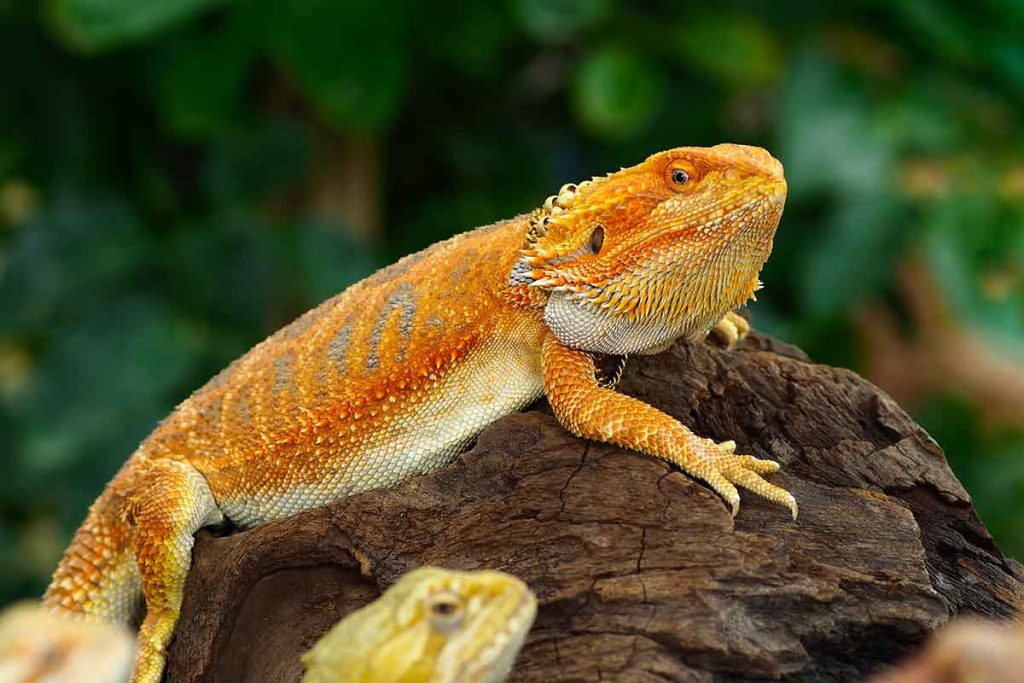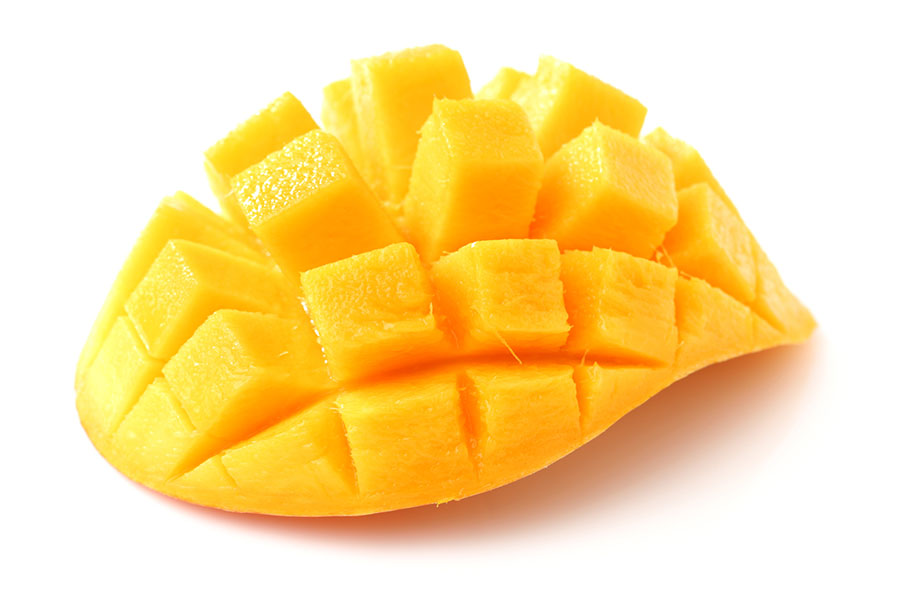Bearded dragons need a lot of variety in their diet to keep them healthy and maintain their interest in their food. When looking for things to add to your bearded dragon’s diet, you may be wondering: can bearded dragons eat mango?
Mangoes can be part of your bearded dragon’s diet in very small quantities. It is a fruit, and fruit in general should only make up 5% to 10% of your bearded dragon’s total diet. This is because fruits are very high in sugar and quite low in other vital nutrients such as
However, bearded dragons tend to love the taste of fruit, particularly sweet, juicy fruits like mango! This makes it helpful for increasing your beardie’s interest in their salads and gaining your scaly pal’s trust.
When considering whether you should include mangoes in your bearded dragon’s diet, you need to consider how they can benefit your bearded dragon and how they can harm your bearded dragon.
In short, mangoes should be included in your bearded dragon’s diet only as an occasional treat item to boost hydration and to help with encouraging interest in their food when they lose it. Keep reading to find out how best to feed your bearded dragon mangoes and what to pair them with to make a balanced meal.
How to Prepare Mango for Your Bearded Dragon
Although bearded dragons can safely eat small amounts of mango from time to time, the fruit needs to be carefully prepared before it makes it to your beardie’s plate.
First, mangoes should be washed carefully before being cut up. Mango skin is often coated in pesticides, herbicides, and waxes, even if they are labeled as organic. If pesticides are left on the skin, they can be transferred to the flesh of the fruit while cutting.
Herbicides, pesticides, and waxes are all detrimental to bearded dragons and can build up in their systems to a fatal level. Therefore, it is essential you wash the fruit before cutting it up.
Once the fruit is washed, carefully peel it and remove the large seed in the center. Cut the fruit up into small pieces no larger than a quarter inch in size.
Alternatively, you could also mince the mango up into even smaller pieces or blitz it into a puree. You should feed no more than three of these quarter-inch pieces to your bearded dragon in a single day. Add the mango pieces to the top of your bearded dragon’s as a topper or mix them up with the salad.
Bearded dragons can sometimes lose interest in their food because of the taste or the texture. If you notice your bearded dragon has stopped eating its food or seems disinterested in their salads, add some mango in! Humans love the taste of mango, and so do bearded dragons.
If you blitz the mango into a puree, you can mix the rest of the salad in it to coat the healthy greens and vegetables with yummy mango. This could reignite your bearded dragon’s interest in their food and provide them with a sweet, tasty treat to look forward to on occasion.
Nutritional Information: Mangoes
Mangoes are very delicious to both humans and bearded dragons. However, these delicious, juicy fruits are not very nutritionally beneficial. For starters, they contain a lot of water and fiber, which is good; however, they also have a poor
Let’s take a closer look at all of the nutritional pros and cons of feeding your beardie mango below.
Nutritional Benefits
Mangoes are so juicy because they have very high water content. This makes them great for boosting hydration in bearded dragons. Remember, bearded dragons do not recognize standing water as actual water, so they can suffer from dehydration even if they have a water dish in their enclosure.
By offering them food that has high water content, bearded dragons can maintain their hydration levels even if they do not drink actual water from a water dish. If your bearded dragon is dehydrated, you can offer them a few small pieces of mango over the course of a few days to boost their levels and get them to a healthy place.
Keep in mind that too much water can cause your beardie to have runny stools. If you notice your dragon’s poo is more watery than usual after eating mango, stop feeding your bearded dragon mango and other water-heavy foods for a few days (or until their next bowel movement).
Another reason why mango is very beneficial to bearded dragons is it has a lot of fiber. Dietary fiber is very important for reptiles because it impacts gut health. Fiber helps to clean out the digestive system of all food. This improves colon health and helps prevent impaction.
Dietary fiber also helps maintain the microbiome in the gut by balancing out the bad and good bacteria.
Nutritional Disadvantages
Although mangoes are delicious and nutritious to an extent, all good things in life are only good in moderation and not in excess. Too much mango in the diet can lead to severe health problems for your bearded dragon.
Bearded dragons need
Foods that are high in phosphorus should be avoided. This is because phosphorus (P) binds to
Mango has a 1:1.4
Mangoes are also very sugary. Too much sugar will lead to obesity. Obesity is a big problem for bearded dragons because it puts strain on their organs such as their heart, liver, and kidneys. It can eventually lead to death.
Sugar also leads to tooth rot. Tooth decay in bearded dragons is very dangerous because their teeth are rooted deeply in their jaws. If left untreated, the tooth decay will affect their jaws and entire systems very quickly.
In short, while mango does have some nutritional benefits, it should only be offered to your beardie as an occasional treat due to its high sugar content and poor Ca:P ratio.
What Should Your Bearded Dragon Eat with Mango?
As we’ve already covered above, your beardie should only eat a small amount of mango on occasion, or no more than once or twice a week. Though it works well as a salad topper, it certainly is not a staple food.
Whether your bearded dragon is a baby or an adult, fruit in general should make up no more than 5% to 10% of their total diet. They need an array of other foods in their diet to make up the other 90%. This 90% needs to be made up of plant matter that is high in
Young bearded dragons need a diet that follows this ratio:
70% animal protein : 20% vegetables and greens : 10% fruit, herbs, and flowers
Adult bearded dragons need a diet with this ratio:
70% vegetables and greens : 20% animal protein : 10 fruit, herbs, and flowers
It is important to stick to these ratios, as bearded dragons need different levels of nutrients as they grow. Young bearded dragons need a lot more protein, whereas adult bearded dragons need a lot more fiber and
The plant matter portion of your bearded dragon’s diet can be made up of various greens and vegetables.
Here are some highly nutritious greens and veggies to include in their daily salads:
- Collard greens
- Arugula
- Endive
- Grape Leaves
- Escarole
- Dark lettuces
- Mustard greens
- Dandelion greens
- Yellow and orange squash
- Bell peppers
- Sweet potatoes
- Carrots
- Pumpkin
Your bearded dragon should also have a range of animal protein in their diet made up of insects and worms.
Some excellent choices of feeder insects are:
- Hornworms
- Nightcrawlers (very large earthworms that will need to be cut up)
- Earthworms
- Dubia roaches
- Crickets
- Phoenix worms (also known as black soldier fly larvae or NutriGrubs)
- Mealworms
For a more intensive look at what your bearded dragon can eat, have a look at our guides on the best worms, the best insects, the best greens, the best vegetables, and the best fruit to feed bearded dragons.
Other Great Fruits for Bearded Dragons
Even though bearded dragons should have some fruit in their diets, mangoes are not always the best option because of their especially poor
However, there are many different fruits you can offer your bearded dragon as an alternative to mango that are just as delicious! Three great options are figs, blackberries, and papaya.
Fruit is generally high in phosphorus, so try to stick to fruits that are low in phosphorus and high in
You can also widen the range of fruit you give your bearded dragon by boosting the amount of
At the Tail End of Things…
As a rule, bearded dragons can eat mango at most once or twice a week in very small portions. You need to portion the mango out very carefully! While this tasty fruit is high in water and dietary fiber, it also contains a lot of sugar, which causes obesity and tooth decay.
More importantly, mangoes have a poor
If you want an alternative to mangoes to add to your bearded dragon’s salad, you could include figs, blackberries, or papaya! Always check the phosphorus levels of any fruit before adding it to the salad to determine if you need to add in additional





